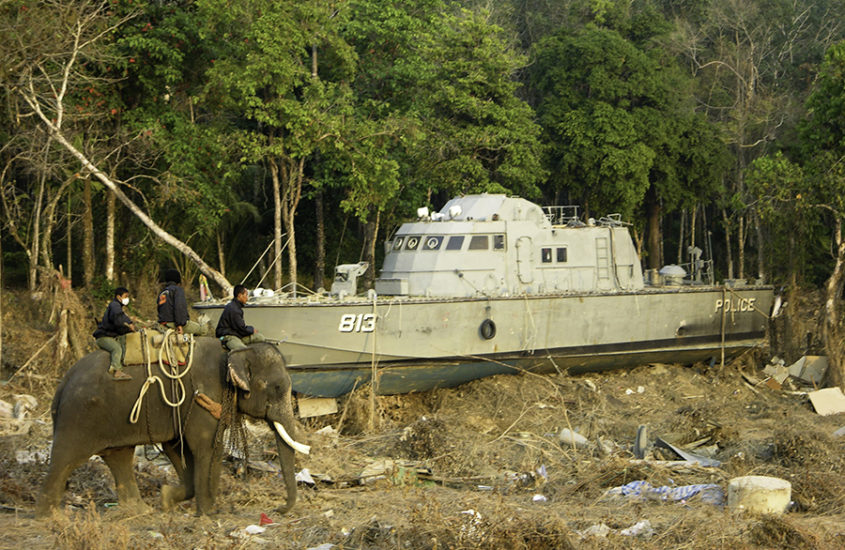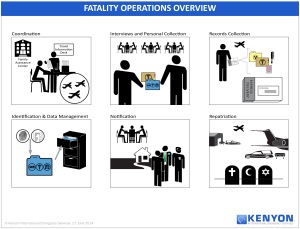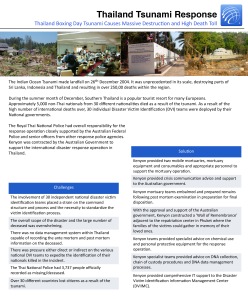Part 9: Fatality Operations

This is part 9 of a 12-part series describing the consequences of a typical large-scale loss of life incident. Following the framework of the 12 Principles of Crisis Management, I describe these consequences and offer best practice solutions for each consequence.
Consequence 9
There are deceased people who need to be recovered, identified and repatriated; or missing people who eventually may be declared dead. This process may be completed by a government agency or by a combination of government and private specialist companies. It will include collecting information from families and a physical examination of the body. Some of the deceased may be family units. With some, there may be issues over who is the legal next of kin, sometimes called the Person Authorized to Direct Disposition (PADD) or problems determining the heirs of the deceased. Finally, family members may have religious or spiritual requirements that should be considered and observed if possible.
Solutions
This is a job for a fatality support team. Presuming that you are working with a government or private company that is responsible for the search, recovery and identification of deceased, this leaves four keys areas to focus on and plan for. The four areas are: (1) missing persons / survivor reporting, (2) ante mortem information collection, (3) repatriation support, and (4) setting expectations.
Firstly, a significant part of identifying deceased in a large loss of life event, especially one in which there is fragmentation, is getting a clear total on who is missing or unaccounted for. Governments do not often link the two together because they have no central system for that. Or there are many governments involved, and they are not looking at the big picture – only their citizens. It is often left to the private companies involved to coordinate this. So it is important to collect any information you have on whom you think is missing and whom you think survived. For example, this could be a manifest or building entry logs.
In the event that the recovery and identification will be a long process, the collected information can then be used when working with the local judicial authorities and to request court ordered death certificates. Death certificates are very important for the families. Without a death certificate, there is little the family can do in taking care of estates, financial matters or other normal probative issues.
Secondly, there is the need to collect the information required to make the identification. This is commonly referred to as the ante mortem record. Ante mortem records are a collection of information and references about a missing person. They include medical and dental history, physical descriptions, pictures, fingerprints or location of any direct DNA references which may have been provided before the incident. These records and references can then be used by those working with the human remains to help establish a positive legally sustainable identification.
Your role is help the families gather these records and quickly transport them to the family assistance center or the mass fatality morgue. It is also to provide support to the families during the family interviews, when they are asked numerous and detailed questions about their loved ones. Again, this is all part of the identification process.
The third area of focus is managing the repatriation of the deceased. Part of your team should be able to help families with making arrangements for and managing the repatriation of the deceased. There are many legal documents that will have to be completed, which can be confusing for families. The actual arrangements of flights and ground transport for the deceased also have to be made and coordinated. Finally, establish a company policy on what services you provide or compensate for; including whether or not it is appropriate for company representatives to attend individual funeral or memorial services.
Training, in this area like all areas is vitally important. For example, it is important to not equate the identification of a deceased person to a body being ready for repatriation. These are two very different functions involving different and multiple government agencies and logistics. Repatriations are not simple. Trained staff know to tell families not to schedule funerals and memorial events until their loved one has been returned home.
Fourthly, because this is an area where businesses or other non-government organizations may have a much more limited role, a key part of the solution is you having a clear understanding of the process. That way, you can help communicate the process to the families and help set clear expectations. This isn’t easy. It is an area that few people have real experience in. The process of recovery, identification and repatriation of the deceased can take months, especially in events such as explosions, fire or aircraft accidents that result in trauma and fragmentation of the deceased. If you are the main contact with families, they will look to you to solve problems.
Examples
This is a hard area. Often no one wants to explain to families that the recovery and identification of a loved one can take weeks, months or years or that there is no “body,” but only “fragments.” It is one of the hardest parts of my job. Certainly families are not looking forward to the information. Logistically, it would be easier to just to tell them very little and return a coffin, weighted if needed, to match their loved ones weight. A few families may even appreciate that. Beyond the basic fact that it is wrong to lie to a family; it is also illegal. It is also something the majority of the families would never want. They will seek the truth, until they are comfortable in the facts. Identifications must be forensically based in clearly outlined procedures.
As an example, read this excerpt from a story by Vanessa Gera of the Associated Press:
“Forensic testing has proven that two more victims of the 2010 plane crash in Russia that killed President Lech Kaczynski of Poland and 95 others were misidentified and buried in the wrong graves,” Polish prosecutors said Wednesday. “The number of misidentified victims has now grown to six and highlights flaws in the handling of the crash’s aftermath in Russia. Such errors are deepening Polish distrust of its historic foe, while also fueling Polish conspiracy theories about the cause of the disaster.”
Downloadable Resources:
The following PDFs include an example of how Kenyon structures coordinated fatality operations, and a case study outlining Kenyon’s involvement in the Thailand Boxing Day Tsunami in December 2004. Both resources illustrate the resources necessary for large-scale fatality operations.


